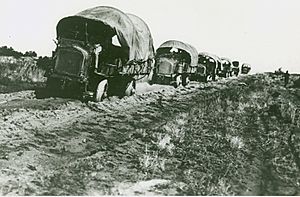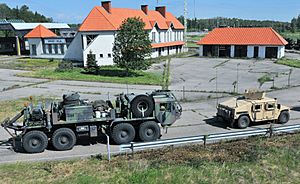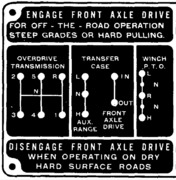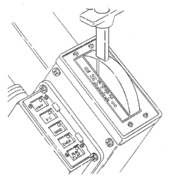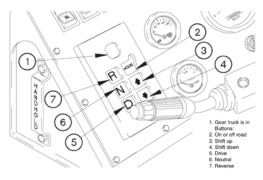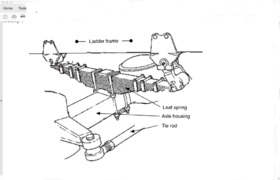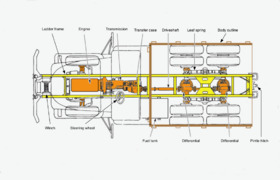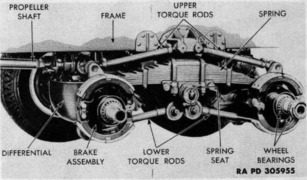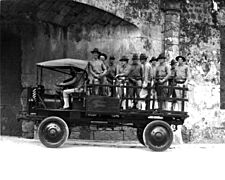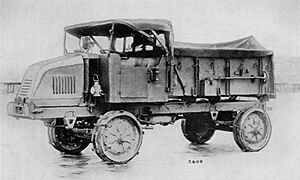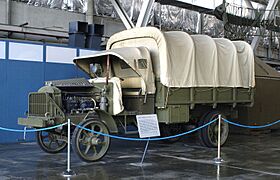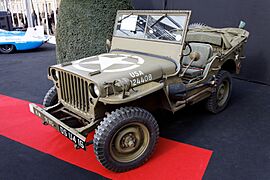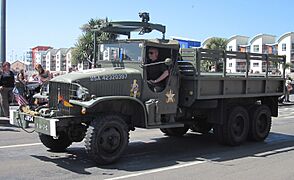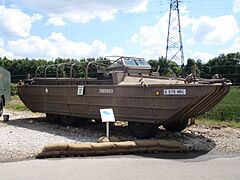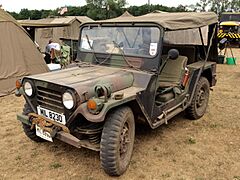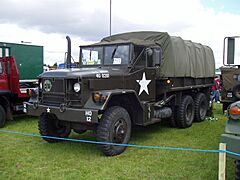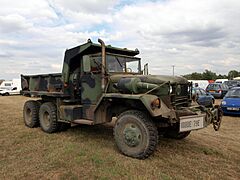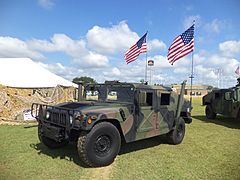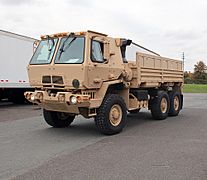United States Army trucks facts for kids
In 1915, the US Army started testing trucks that were made to go off-road. They wanted to see if trucks could replace horses and mules. Since then, the Army has built many different kinds of trucks. They also had private companies build trucks for them.
Contents
Army Trucks: An Overview
Army trucks are measured by how much cargo they can carry. This is usually in tons. One ton is about 907 kilograms. The same type of truck can have different bodies. For example, a cargo truck might also be a dump truck.
Trucks are also measured by how many wheels are powered. Off-road trucks have all-wheel drive.
- A truck with two axles (four wheels) is called a 4x4.
- A truck with three axles (six wheels) is a 6x6.
- A truck with four axles (eight wheels) is an 8x8.
If a truck has two tires close together on one side, it counts as one wheel.
Until the 1990s, most Army trucks had the engine in front of the driver's cab. This is called "conventional" in the US. In the 1990s, the Army started using new types of trucks. Most new trucks can have special armor on the cab to protect the driver.
Medium and large trucks often have the cab over the engine ("COE"). This means the front of the cab looks flat. A new large truck has the cab in front of the engine ("forward control"). This type has two axles under the engine, and both axles can steer.
The Army tries to use the same parts in many different trucks. This makes it easier to fix them. But they also use different parts in the same truck. For example, a truck's engine and transmission might come from different companies. Also, different companies can build the same type of truck.
The Army still uses many older trucks. They were built very strong. They can be updated with new engines and transmissions. The Army also uses trucks made for everyday people. Large trucks with three rear axles pull tanks on special trailers. Other regular trucks, some with armored cabs, are also used. The US Marines use many Army trucks, but they also have their own special types.
How Army Trucks Work
Engines
The Army used gasoline engines until the 1960s. After that, they started using diesel engines. Some older trucks could even use a mix of gasoline or jet fuel with diesel. Today, Army trucks use the same diesel engines found in many regular trucks.
Most Army trucks have water-cooled engines with six cylinders in a row (I6). Smaller Jeeps have four-cylinder engines in a row (I4). Some small 1¼-ton trucks have V8 engines. There are a few unusual engines too.
Transmissions
Most old Army trucks had manual transmissions, where the driver shifts gears. Now, most new trucks have automatic transmissions. A special part called a transfer case is behind the transmission. It sends power to the front wheels. Trucks with manual transmissions often have a very low gear for driving slowly on rough ground. Automatic trucks usually don't need this low gear.
Chassis
A truck's frame is like its skeleton. A common type is a "ladder frame." It has two long rails from front to back, connected by smaller rails, like a ladder. The front axle, which helps steer and power the truck, is held by leaf springs. These are like stacks of metal leaves that absorb bumps.
Some trucks have two axles close together at the back, called "tandem axles." They are held differently, with leaf springs and arms. Some springs are above the axles, and some are below. A few very heavy-duty trucks use a simple, strong "walking beam" system.
History of Army Trucks
Early Days: 1915-1939
In 1915, the US Army began testing trucks that could drive off-road. They wanted to see if trucks could replace horses. Trucks could carry more weight and were easier to take care of. A truck can run as long as it has fuel and doesn't break down. Horses need food, rest, and can get sick. Tests showed that trucks worked better than horses. The Army started replacing all horses and mules with trucks. One of the testers, Lieutenant Dwight D. Eisenhower, later became a US President.
In 1914, World War I started in Europe. The British Army began buying American trucks. Trucks like the "Bulldog" Mack were good, but roads in Europe were often muddy and bad.
In 1915, the US Army was chasing a Mexican revolutionary named Pancho Villa. They tested 4x4 trucks built by the FWD Company and Jeffery Company. These trucks passed the tests and were later built for World War I. Other companies also built these same trucks. The Army liked having more than one company build the same trucks. This meant more trucks could be made, and if one company had problems, others could keep building. A standard "Liberty" truck was built by 15 different companies during World War I.
In the 1920s, the Army built and tested a few trucks. Truck builders didn't do much new. Then, in 1930, the Army built a test group of trucks. These trucks were strong and reliable. But the American truck builders complained that the Army was taking their business. So, the Army had to stop building its own trucks. It was the Great Depression, and the Army had very little money for trucks. Builders started making test models again in 1935. By 1939, over 20 builders had made and improved test models.
World War II Era: 1940-1949
In 1940, the Army wanted many new off-road trucks. They needed 4x4 trucks that could carry ¼-ton, ½-ton, 1½-ton, and 5-tons. They also wanted 6x6 trucks that could carry 2½-tons, 4-tons, 6-tons, and 7½-tons. Trucks were tested and improved. Good trucks were built in very large numbers. Some popular trucks were built by more than one company. For example, 6-ton trucks were built by five different companies.
During World War II, the US made a huge number of trucks. Many were loaned to other countries that were fighting with the US. In 1945, when the war ended, truck building stopped. There were too many trucks for the Army to use. Many were left in the countries where they had been used. Jeeps and 2½-ton trucks could be found all over the world. Most were used by armies, but some were sold to regular people.
Post-War Trucks: 1950-1979
After World War II, the Army planned new trucks. Many trucks had worked well, but there were too many different types. The Army wanted fewer types of trucks. They also wanted trucks that any company could build. They decided on ¼-ton and ¾-ton 4x4s, and 2½-ton, 5-ton, and 10-ton 6x6s. These new trucks used many of the same parts. All the large trucks even used the same cab.
In 1950, the Army started using "M" numbers to name trucks and their different bodies. Every truck, with every different body, got its own number. For example, an M35 is a cargo truck, and an M36 is the same truck but with a longer cargo body.
These truck types didn't change much for 25 years. A new Jeep (M151) was used starting in 1960. The ¾-ton truck changed to a 1¼-ton size, similar to a civilian truck. The larger trucks were updated, but they were still based on the 1950s designs.
Modern Trucks: 1980-2015
In 1980, the Army began using new types of trucks. They started using letters to name truck types. Most of these new trucks can have armor added to them. New trucks no longer use dual tires (two tires close together on one side). On most new trucks, the driver can change the air pressure in the tires while driving. This is called the "Central Tire Inflation System" (CTIS).
The smallest modern truck is the 1¼-ton HMMWV, often called a "Hum-V" or "Hummer." The Army started using Hummers in 1983. It was built just for the Army, not changed from a regular civilian truck.
The Army also uses European trucks for its 2½-ton and 5-ton sizes. The 2½-ton truck has two axles (4x4), and the 5-ton truck has three axles (6x6). Most parts are the same for both.
A new, very heavy-duty 10-ton 8x8 truck (with four axles) was built just for the Army. These trucks can have many different bodies. Many of them have cranes to help load cargo onto the truck.
-
HEMTT 10-ton 8x8
Some Army Truck Models
¼-ton "Jeep"
| Name | Years Built | Total built | Notes |
|---|---|---|---|
| Willys MB | 1941-1945 | 639,000+ | |
| M38A1 (Willys) | 1952-1971 | ||
| M422 "Mighty Mite" | 1959-1962 | 3,922 | USMC very light utility |
| M151 (Ford) | 1960-1988 |
¾ to 1¼-ton Trucks
| Name | Years Built | Total built | Notes |
|---|---|---|---|
| Dodge WC | 1941-1945 | 255,000+ | 10+ bodies |
| M37 Series (Dodge) | 1951-1968 | 115,838 | "Power Wagon" |
| M715 (Kaiser-Jeep) | 1967-1969 | ||
| M880 (Dodge) | 1976-1977 | Civilian pickup truck | |
| M1008 CUCV(Chevrolet) | 1984-1987 | Civilian pickup truck | |
| M998 HMMWV | 1983 | Can be armored |
1½-ton Trucks
| Name | Years Built | Total built | Notes |
|---|---|---|---|
| Chevrolet 7100 (G509) | 1940-1945 | 168,603 | 15 bodies |
| M561 "Gamma-goat" | 1970- | 14,000 | 6x6 (2 truck axles and one trailer axle) |
2½-ton Trucks
| Name | Years Built | Total built | Notes |
|---|---|---|---|
| GMC CCKW | 1941-1945 | 562,750 | "Deuce and a Half," "Jimmy" |
| GMC DUKW | 1942-1945 | 21,147 | "Duck" amphibious CCKW |
| Studebaker US6 | 1941-1945 | 219,882 | 8 bodies |
| M35 (GMC) | 1950-1988 | 8+ bodies | |
| M35 (REO) | 1950-1991 | Standard medium truck 1950-1991 | |
| M1078 LMTV | 1991- | Family of Medium Tactical Trucks 4x4 |
4 to 6-ton Trucks
| Name Type |
Years Built | Total built | Notes |
|---|---|---|---|
| Diamond T 968 4-ton 6x6 |
1940-1945 | 30,000 | Cargo, dump, wrecker and specialty bodies |
| M54/M809/M939 5-ton 6x6 |
1990-1982 | Standard heavy truck 1950-1991 | |
| M1083 MTV 5-ton 6x6 |
1991- | Family of Medium Tactical Trucks 6x6 | |
| Autocar U8144T 5 to 6-ton 4x4 |
1941-1945 | 2,711 | Semi-tractor for pontoon bridges |
| Brockway B666 6-ton 6x6 |
1941-1945 | 219,882 | Bridge, crane, cargo, fire, van, and others. |
Larger Trucks
| Name Type |
Years Built | Total built | Notes |
|---|---|---|---|
| M123 (Mack) 10-ton 6x6 |
1955-1969 | 4,132 | Semi-tractor tank transporter |
| M977 HEMTT 10-ton 8x8 |
1982 | ||
| M20 (Diamond T) 12-ton 6x4 |
1941 1945 |
6,554 | Tractor tank transporter, diesel engine, no front wheel drive, |
| M26 (Pacific) 12-ton 6x6 |
1943-1945 | 1,372 | Semi-tractor tank transporter (armored and unarmored models) |
Early Trucks: 1915-1935
| Name Type |
Years Built | Total built | Notes |
|---|---|---|---|
| Jeffery Quad 2-ton 4x4 |
1913-1928 | 11,000 | Early ones had 4-wheel steering |
| FWD Model B 3 to 5-ton 4x4 |
1912-1920 | 16,000 | |
| Standard Group II 3 to 4-ton 4x4 |
1931-1932 | 60 | Entire line of test trucks |


